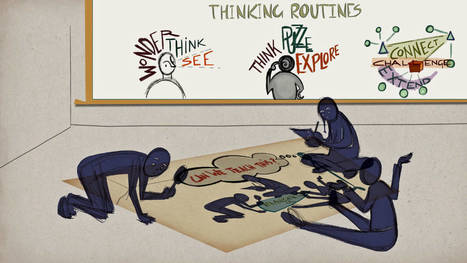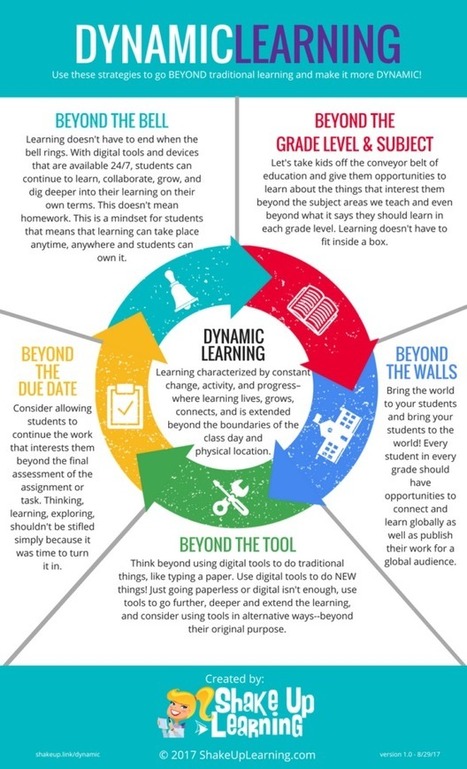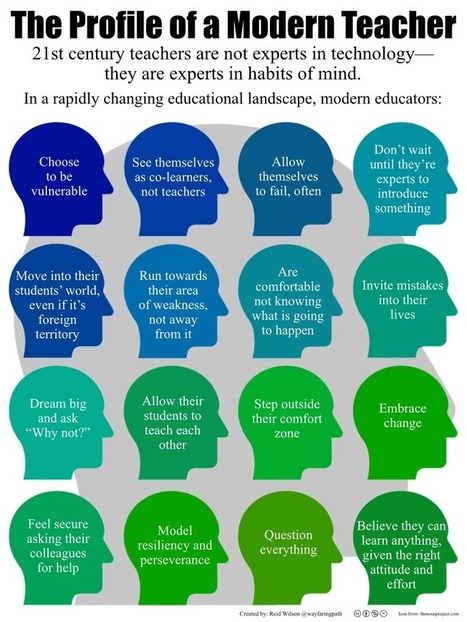Have you been following all the coverage about the fourth industrial revolution – Industry 4.0, as it’s sometimes called? Big data, artificial intelligence and robotics will fundamentally change the way products are designed and built and how services are provided. They are already changing how we live and communicate.
Get Started for FREE
Sign up with Facebook Sign up with X
I don't have a Facebook or a X account
 Your new post is loading... Your new post is loading...
 Your new post is loading... Your new post is loading...

Joyce Valenza's curator insight,
August 14, 2017 8:57 AM
An interview with Dr. Dweck that offers insights and counters myths.

Rosemary Tyrrell, Ed.D.'s curator insight,
August 14, 2017 12:27 PM
Interview with always interesting Carol Dweck. I appreciate the nuance of what she is discussing here. 
Ian Berry's curator insight,
August 14, 2017 7:15 PM
Great reminders of several aspects what I call appreciative leadership. "Effort is one factor that leads to learning. So the ultimate value is growth, progress, learning. And effort is one thing that leads there but there are many other things – strategies, using resources, getting advice, guidance and mentorship, and when people leave that out and just praise effort, it’s not transmitting a growth mindset."

Nataliia Viatkina/Наталія Вяткіна's curator insight,
March 26, 2017 4:20 AM
Professional development for teachers themselves, as personalities, adult people, universally, independently from schooling is very interesting idea, humanistic , and useful for school eventually

Prof. Dr. Kai Reinhardt's curator insight,
March 30, 2017 2:42 AM
Hier gibt es eine gute Sammlung an neuen Wissenstransfer-Formaten...
R's curator insight,
April 6, 2017 1:31 PM
Growth and learning beyond schooling - think outside in-service and conferences/professional workshops.
Lina Kherfan's curator insight,
April 3, 2016 8:19 PM
this article talks about the importance of how children think and learn. the author stresses on the fact that for better learning, students need to have a better structure for learning, hence the title. the author states students often do not have a good structure for thinking. students tend just to memorize things and don't know how to do deep learning. the author states that teachers only teach one part of this structure. which is thinking about thinking. the structre for better thinking is not only thinking about thinking though, there is more to it. the only part of it is to monitoring and directing thinking. " When a student is reading and stops to realize he’s not really understanding the meaning behind the words, that’s monitoring. And most powerfully, directing thinking happens when students can call upon specific thinking strategies to redirect or challenge their own thinking." monitoring is being able to check up on yourself and regulate your own learning and directing is when students can take charge of their learning and direct it to what works for them in their self learning. this article talks about the importance of deeper thinking and learning and then switches to how educators can help with the process. i chose this article because i think that it is an important thing for students in K-12 grades. in my highschool, my graduating year, they had put in place a program called common core, which emphasizes this specific topic in student learning. sadly i was not able to partake in it however i do think that it is important for incoming students learn how to think and learn deeper.
Sara Jaramillo's curator insight,
May 21, 2020 1:27 PM
I agree with what this article says and I consider that education in public schools in Colombia must have into account the theory and the strategies proposed by Ritchhart. It is very important teach students to think by themselves, to take decisions in their learning, to have critical thinking skills, is more useful and meaningful for their learning, that just provide information for them to memorize it. They would not know what to do with this information, and there will be no learning.

Gust MEES's curator insight,
June 14, 2016 3:09 PM
Maker education is currently a major trend in education. But just saying that one is doing Maker Education really doesn't define the teaching practices that an educator is using to facilitate it. Maker education takes on many forms. This post provides an overview of how maker education is being implemented based on the teaching practices…
Learn more / En savoir plus / Mehr erfahren:
http://www.scoop.it/t/21st-century-learning-and-teaching/?tag=pedagogy
http://www.scoop.it/t/21st-century-learning-and-teaching/?tag=Heutagogy
http://www.scoop.it/t/21st-century-learning-and-teaching/?tag=andragogy
https://gustmees.wordpress.com/2015/05/13/andragogy-adult-teaching-how-to-teach-ict/
|

Rubiel's curator insight,
September 16, 2017 10:04 PM
The author shares the idea about going beyond the mere fact of being learning only in the classroom. His thoughts on being more autonomous when implementing tools which provide the learners with the opportunity to practice at home leaves a space to consider the way we are making the education happen nowadays. Thereupon, I agree with the consideration about having learners dig deeper into their learning on their own terms with the tecnological devices found in this new era and let them dig deeper on things the are interested in the most. 
David Alzate's curator insight,
September 17, 2017 6:18 PM
This article advices teachers to help their students see learning as an entire life process, and that with all the tools we have available today it does not have to be boring, limited or seen as a burden. Instead, teachers can help them power and further a mindset of proactivity and independence in learning. It means that the children, teenagers or adults in a class can come to understand ,with their teacher’s help, that learning does not always mean to have a board and a teacher in front of a classroom. This article notes that it is of high importance for teachers to constantly be updated in all the new tools that are available for education, and to learn how to use them beyond the common and old way. In this new, connected and more globalized world, learning does not have to stop necessarily when the school day or year ends, it can be at any time, and also interesting and exciting; the deal here is to have teachers and therefore students thinking out of the box, and seeing education notas a burden or a must, but an enjoyable process insofar as this mindset is well provided and spread.
Sarah's curator insight,
June 4, 2017 8:25 PM
This is a short article on the ways that teachers' roles are changing. It is important to note that teachers are not becoming obsolete, but are just as important as ever. Teachers are here to facilitate learning and assisting the students in becoming resilient, self directed and capable learners.

Mariann Gissella Castillo Herrera's curator insight,
December 3, 2020 12:07 PM
These are the types of changes in the teacher's role that are fundamental to developing students who are capable of independent learning and reinvention in a rapidly changing world.
Luisa Fernanda Giraldo 's curator insight,
December 4, 2020 11:58 PM
We can observe a significant change in the teacher's role. Nowadays, students are more independent in the learning process, and due to the pandemic situation, students are forced to create new study habits to learn by themselves. However, the teacher still plays a fundamental role in classes and provides different tools to help students improve while learning.

Nataliia Viatkina/Наталія Вяткіна's curator insight,
March 26, 2017 4:20 AM
Professional development for teachers themselves, as personalities, adult people, universally, independently from schooling is very interesting idea, humanistic , and useful for school eventually

Prof. Dr. Kai Reinhardt's curator insight,
March 30, 2017 2:42 AM
Hier gibt es eine gute Sammlung an neuen Wissenstransfer-Formaten...
R's curator insight,
April 6, 2017 1:31 PM
Growth and learning beyond schooling - think outside in-service and conferences/professional workshops.
Kathy Lynch's curator insight,
August 16, 2016 7:51 AM
Thx Gust Mees! 3 Common mistakes we all make in Learning. My students often get caught at #1, Embrace discomfort, because they do not appreciate the key fact that "Effective Learning feels difficult". Cramming (#2) has never worked to help us retain learning; we must space and layer our practice. Finally, connect the learning to our lives and current knowledge.

AMLTaylor66's curator insight,
August 26, 2016 11:41 AM
We may graduate from school, but we never stop learning. New jobs, new roles, new relationships: all require the acquisition of new knowledge. To stop learning is to stop improving.
1. Embrace discomfort 2. Stop cramming 3. Make connections
Learn more / En savoir plus / Mehr erfahren:
http://www.scoop.it/t/21st-century-learning-and-teaching/?tag=Effective+Learning

Viljenka Savli (http://www2.arnes.si/~sopvsavl/)'s curator insight,
December 29, 2015 3:21 AM
It would be nice if every and each teacher added one own thought to the list. I add: ...to pass my enthusiasm to them in a pleasant and inspiring way and to understand and respect their own one... 
Inma Contreras's curator insight,
January 5, 2016 9:16 PM
What teaching means... all,nearly all in a real teacher's life. |



















